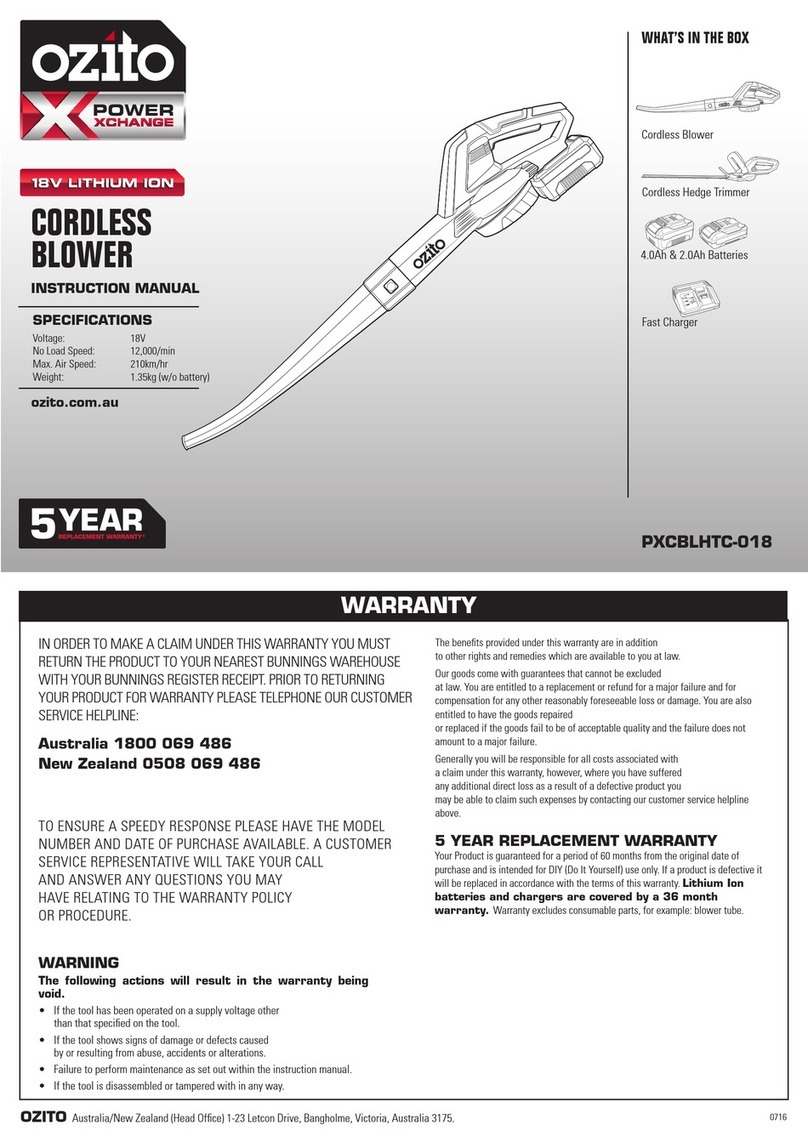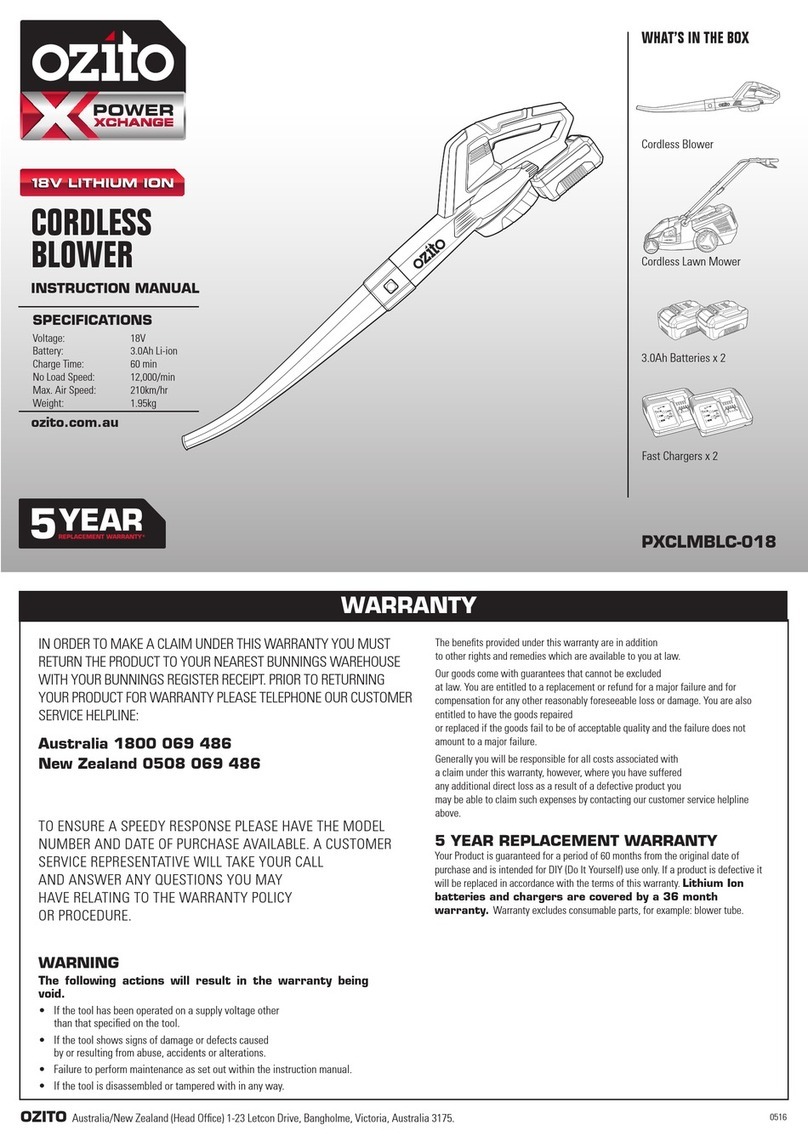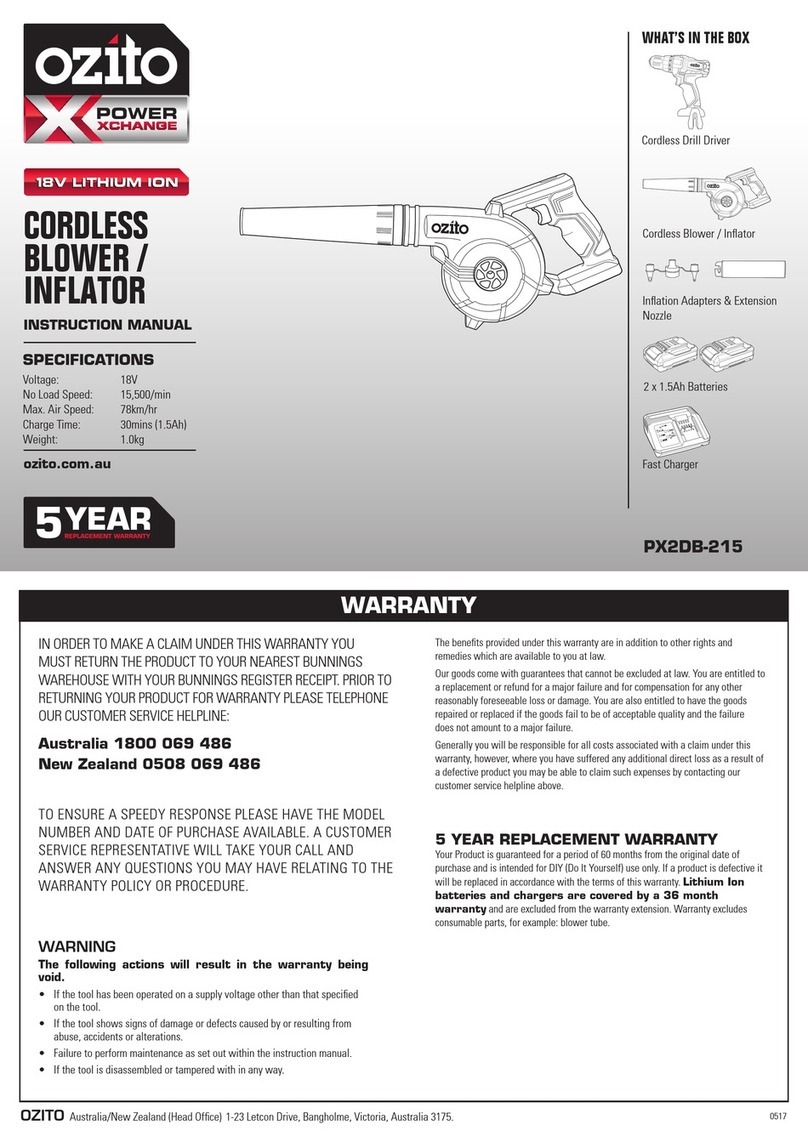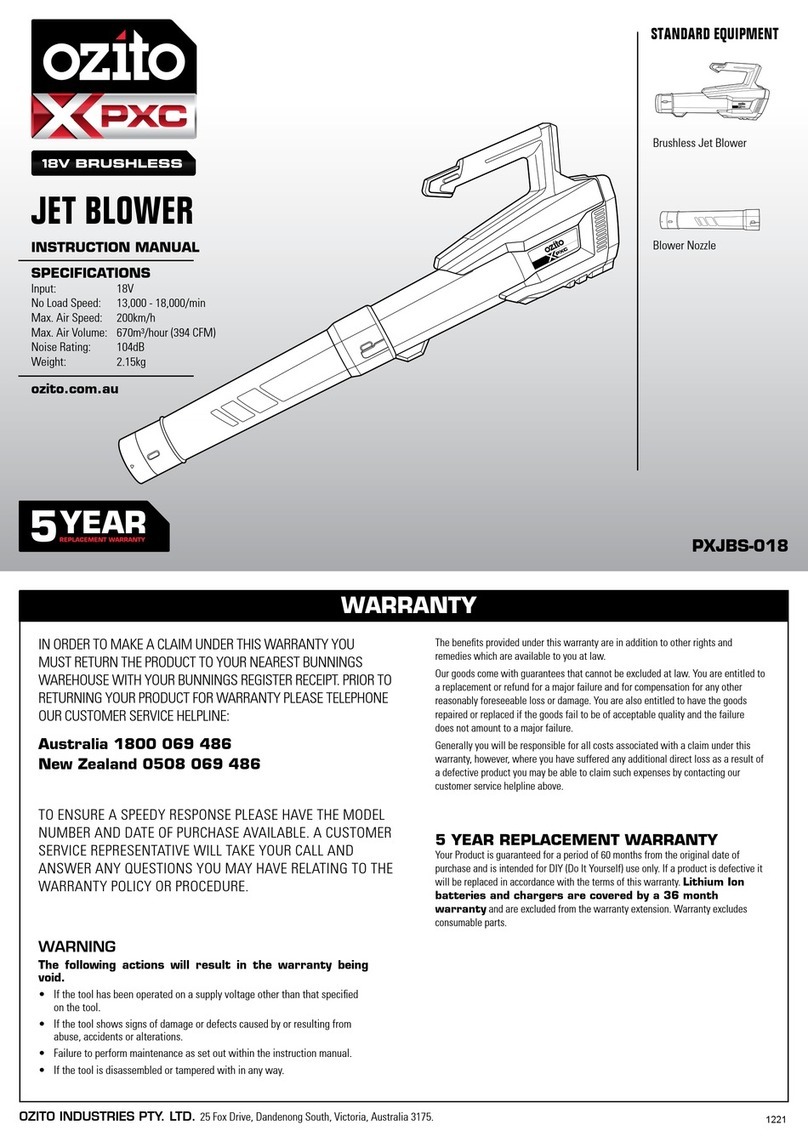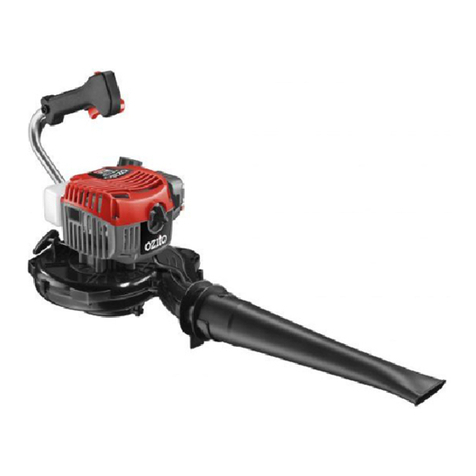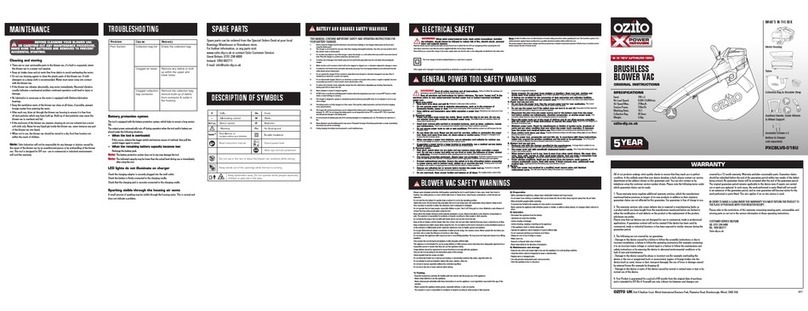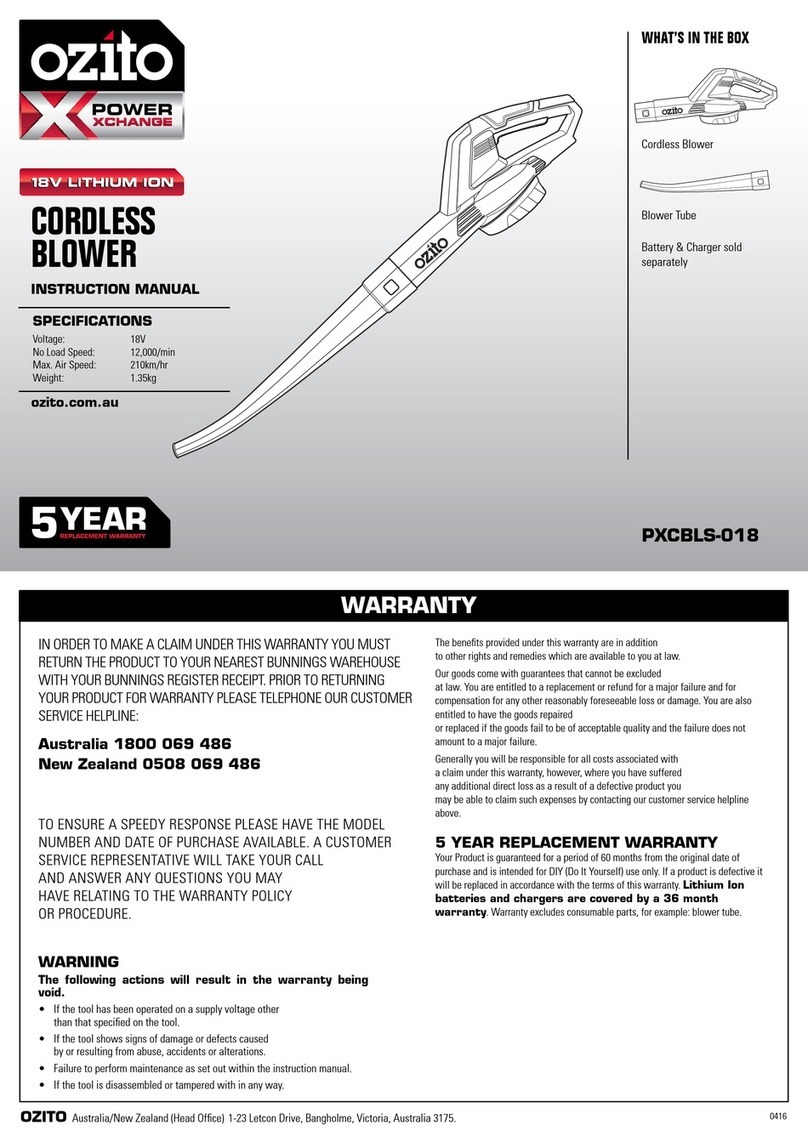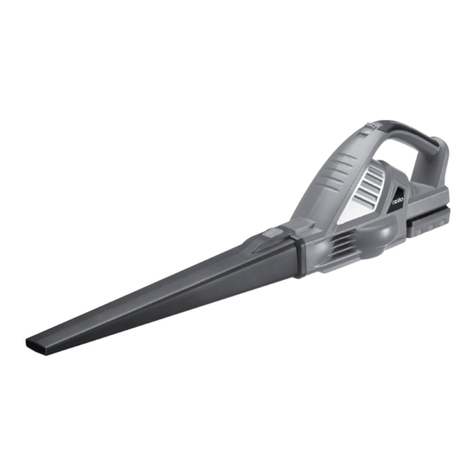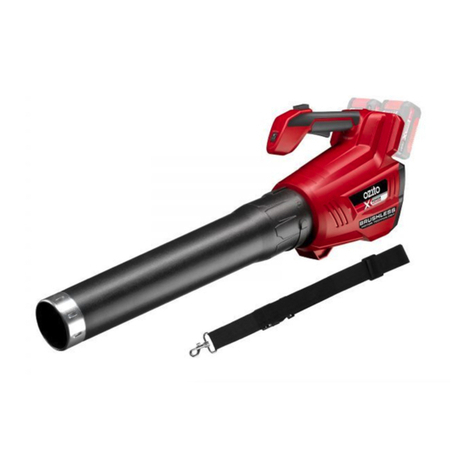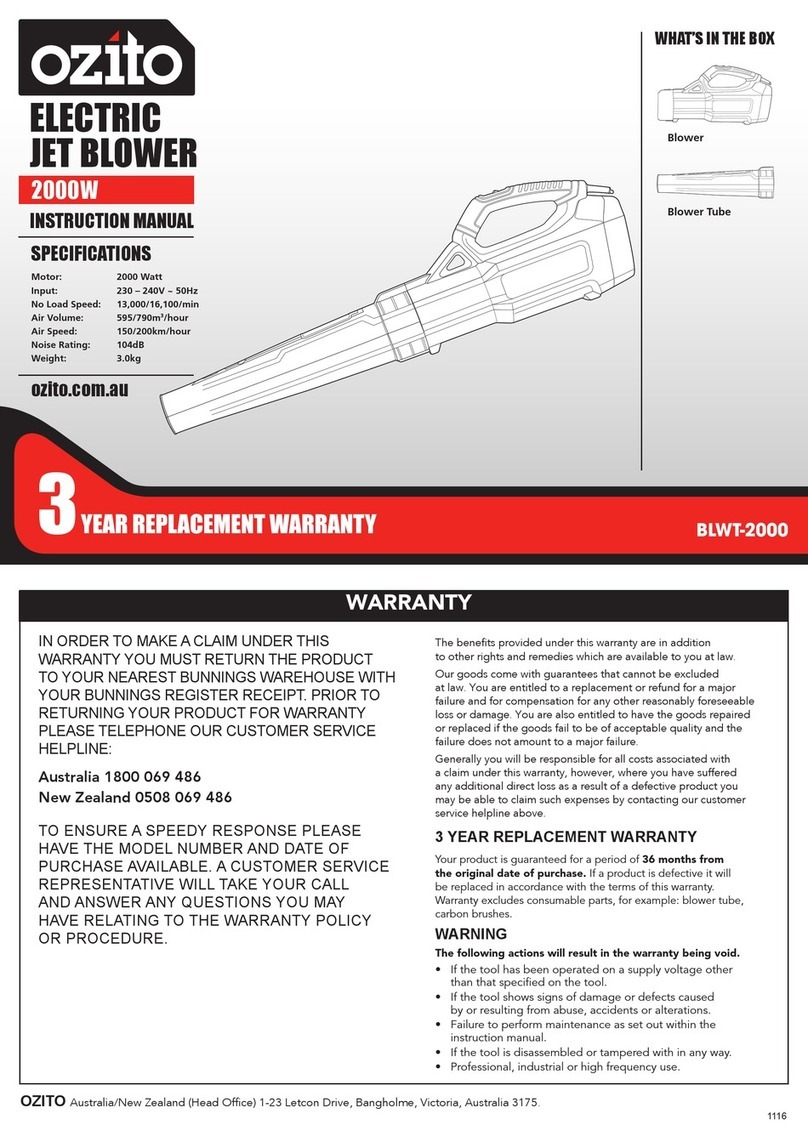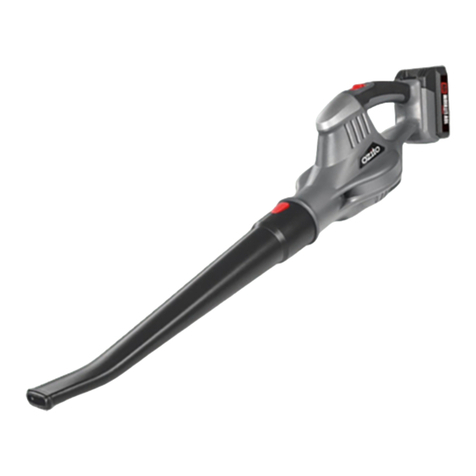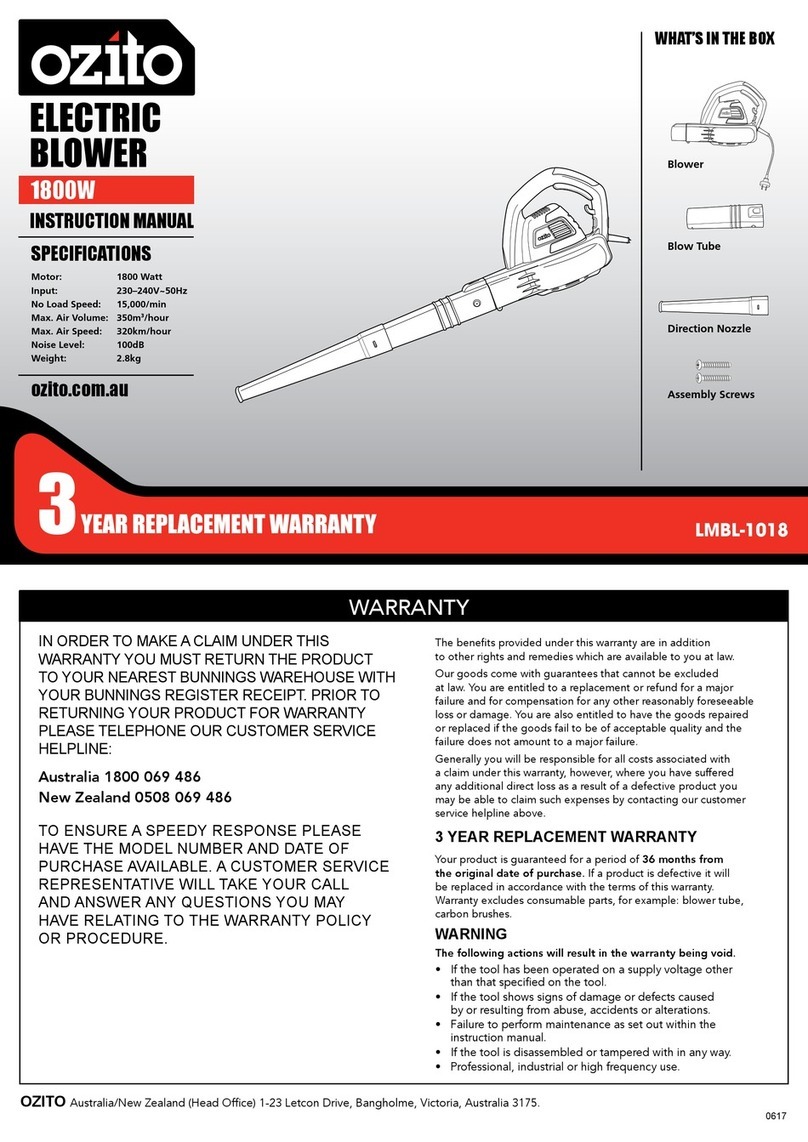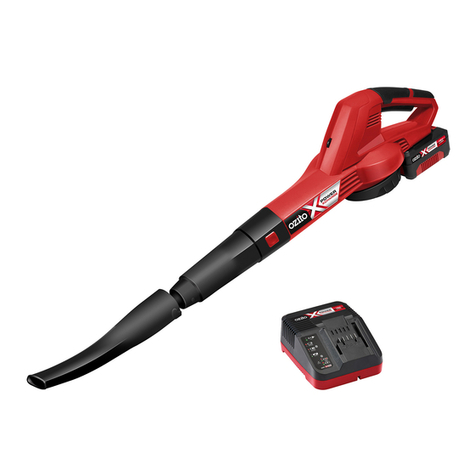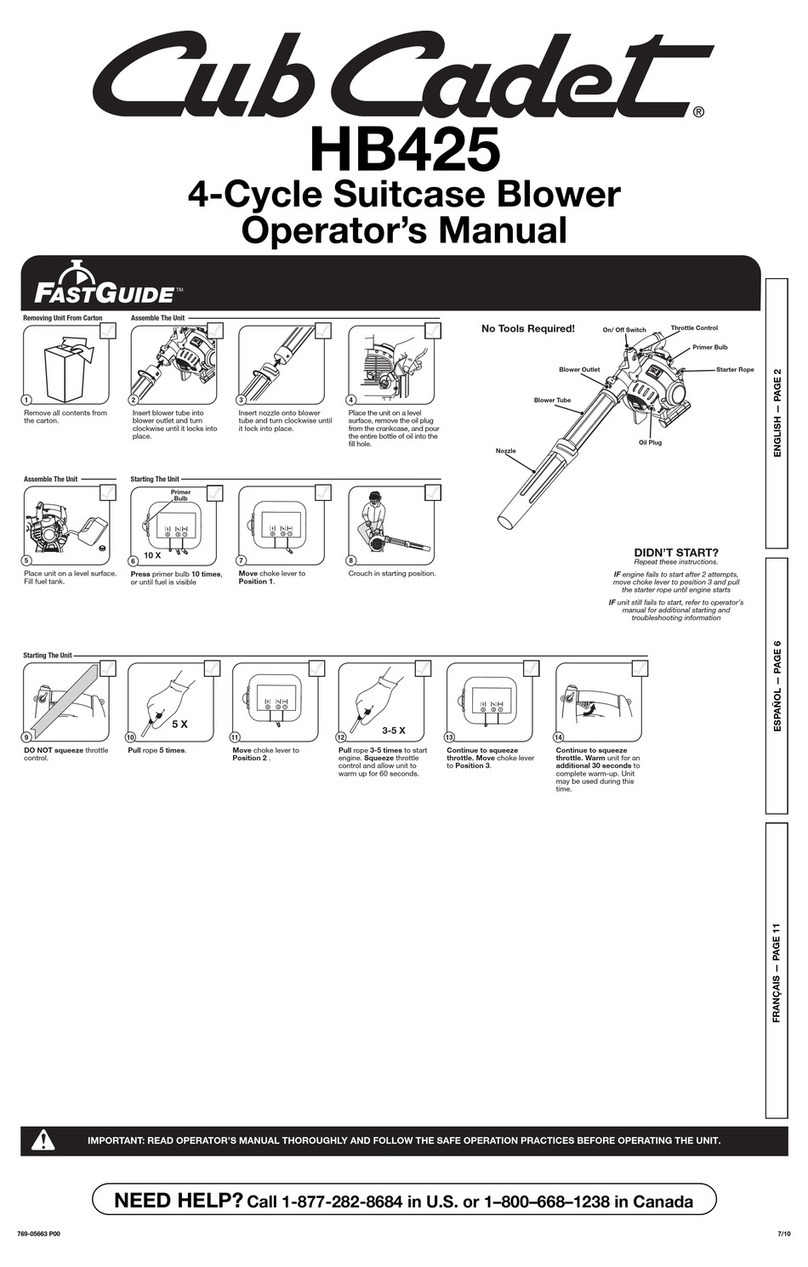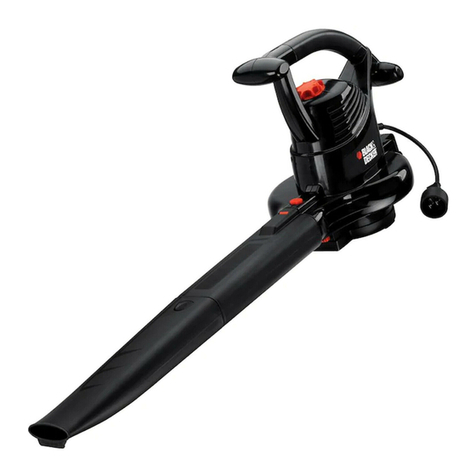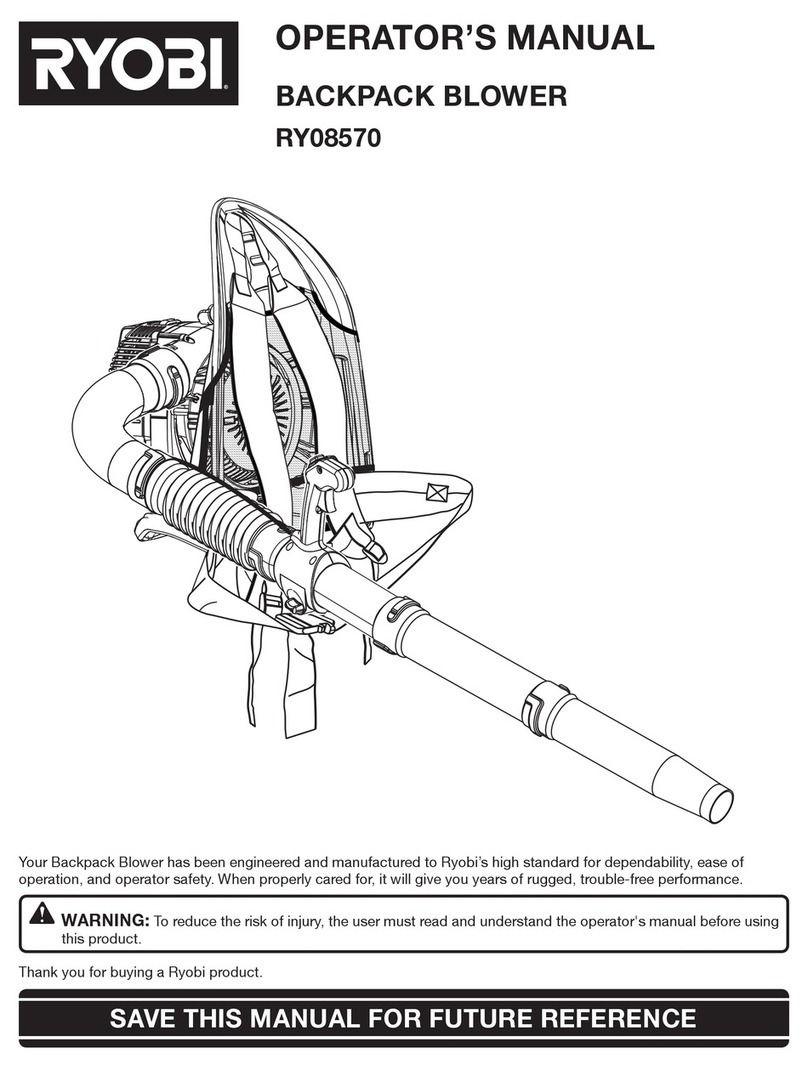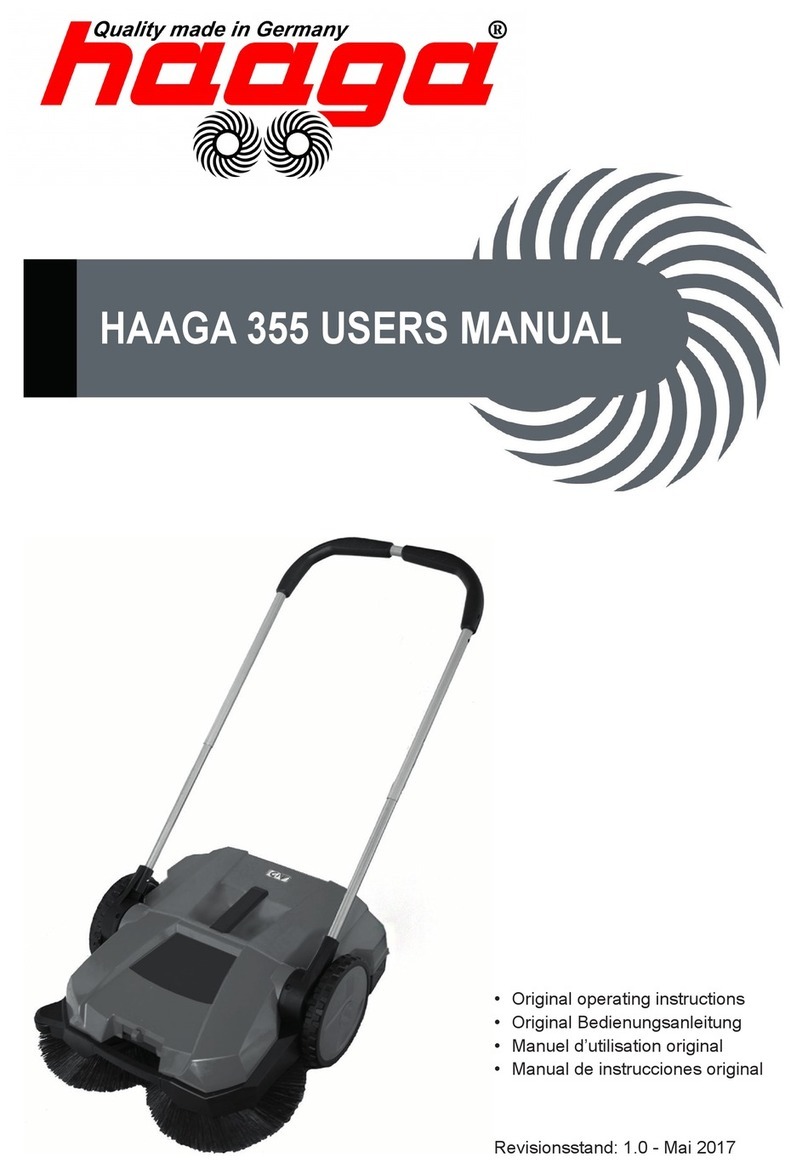
GENERAL POWER TOOL SAFETY WARNINGS
ELECTRICAL SAFETY
BLOWER SAFETY WARNINGS
WARNING! When using mains-powered tools, basic safety precautions, including the
following, should always be followed to reduce risk of re, electric shock, personal injury and
material damage.
Readthewholemanualcarefullyandmakesureyouknowhowtoswitchthetooloffinanemergency,before
operating the tool.
Save these instructions and other documents supplied with this tool for future reference.
The charger has been designed for 230V and 240V only. Always check that the power supply corresponds to
the voltage on the rating plate.
Note: The supply of 230V and 240V on Ozito tools are interchangeable for Australia and New Zealand.
This tools charger is double insulated therefore no earth wire is required.
The power supply for this products charger should be protected by a residual current device
(rated at 30mA or less). A residual current device reduces the risk of electric shock.
Ifthesupplycordisdamaged,itmustbereplacedbythemanufacturer,itsserviceagentorsimilarlyqualied
persons in order to avoid a hazard.
Note: Double insulation does not take the place of normal safety precautions when operating this tool. The
insulationsystemisforaddedprotectionagainstinjuryresultingfromapossibleelectricalinsulationfailure
within the tool.
WARNING! Read all safety warnings and all instructions. Failure to follow the warnings
andinstructionsmayresultinelectricshock,reand/orseriousinjury.
Save all warnings and instructions for future reference. The term “power tool” in the
warnings refers to your mains-operated (corded) power tool or battery-operated (cordless)
power tool.
1. Work area safety
a. Keep work area clean and well lit. Cluttered or dark areas invite accidents.
b. Do not operate power tools in explosive atmospheres, such as in the presence of
ammable liquids, gases or dust. Power tools create sparks which may ignite the dust or
fumes.
c. Keep children and bystanders away while operating a power tool. Distractions can cause you
to lose control.
2. Electrical safety
a. Power tool plugs must match the outlet. Never modify the plug in any way. Do not use any
adapter plugs with earthed (grounded) power tools.Unmodiedplugsandmatchingoutlets
will reduce risk of electric shock.
b. Avoid body contact with earthed or grounded surfaces, such as pipes, radiators, ranges
and refrigerators. There is an increased risk of electric shock if your body is earthed or
grounded.
c. Do not expose power tools to rain or wet conditions. Water entering a power tool will increase
the risk of electric shock.
d. Do not abuse the cord. Never use the cord for carrying, pulling or unplugging the power
tool. Keep cord away from heat, oil, sharp edges or moving parts. Damaged or entangled
cords increase the risk of electric shock.
e. When operating a power tool outdoors, use an extension cord suitable for outdoor use.
Use of a cord suitable for outdoor use reduces the risk of electric shock.
f. If operating a power tool in a damp location is unavoidable, use a residual current device
(RCD) protected supply. Use of an RCD reduces the risk of electric shock.
3. Personal safety
a. Stay alert, watch what you are doing and use common sense when operating a power tool.
Do not use a power tool while you are tired or under the inuence of drugs, alcohol or
medication. A moment of inattention while operating power tools may result in serious personal
injury.
b. Use personal protective equipment. Always wear eye protection. Protective equipment
suchasdustmask,non-skidsafetyshoes,hardhat,orhearingprotectionusedforappropriate
conditionswillreducepersonalinjuries.
c. Prevent unintentional starting. Ensure the switch is in the off-position before connecting to
power source and/or battery pack, picking up or carrying the tool. Carrying power tools with
yourngerontheswitchorenergisingpowertoolsthathavetheswitchoninvitesaccidents.
d. Remove any adjusting key or wrench before turning the power tool on. A wrench or a key left
attachedtoarotatingpartofthepowertoolmayresultinpersonalinjury.
e. Do not overreach. Keep proper footing and balance at all times. This enables better control of
the power tool in unexpected situations.
f. Dress properly. Do not wear loose clothing or jewellery. Keep your hair, clothing and
gloves away from moving parts.Looseclothes,jewelleryorlonghaircanbecaughtinmoving
parts.
g. If devices are provided for the connection of dust extraction and collection facilities,
ensure these are connected and properly used. Use of dust collection can reduce dust-related
hazards.
4. Power tool use and care
a. Do not force the power tool. Use the correct power tool for your application. The correct
powertoolwilldothejobbetterandsaferattherateforwhichitwasdesigned.
b. Do not use the power tool if the switch does not turn it on and off. Any power tool that cannot
be controlled with the switch is dangerous and must be repaired.
c. Disconnect the plug from the power source and/or the battery pack from the power tool
before making any adjustments, changing accessories, or storing power tools. Such
preventive safety measures reduce the risk of starting the power tool accidentally.
d. Store idle power tools out of the reach of children and do not allow persons unfamiliar with
the power tool or these instructions to operate the power tool. Power tools are dangerous in
the hands of untrained users.
e. Maintain power tools. Check for misalignment or binding of moving parts, breakage of
parts and any other condition that may affect the power tool’s operation. If damaged, have
the power tool repaired before use. Many accidents are caused by poorly maintained power
tools.
f. Keep cutting tools sharp and clean. Properly maintained cutting tools with sharp cutting edges
are less likely to bind and are easier to control.
g. Use the power tool, accessories and tool bits etc. in accordance with these instructions,
taking into account the working conditions and the work to be performed. Use of the power
tool for operations different from those intended could result in a hazardous situation.
5. Battery tool use and care
a. Recharge only with the charger specied by the manufacturer. A charger that is suitable for
onetypeofbatterypackmaycreateariskofrewhenusedwithanotherbatterypack.
b. Use power tools only with specically designated battery packs. Use of any other battery
packsmaycreateariskofinjuryandre.
c. When battery pack is not in use, keep it away from other metal objects, like paper clips,
coins, keys, nails, screws or other small metal objects, that can make a connection from
one terminal to another. Shortingthebatteryterminalstogethermaycauseburnsorare.
d. Under abusive conditions, liquid may be ejected from the battery; avoid contact. If contact
accidentally occurs, ush with water. If liquid contacts eyes, additionally seek medical
help. Liquidejectedfromthebatterymaycauseirritationorburns.
6. Service
a. Have your power tool serviced by a qualied repair person using only identical
replacement parts. This will ensure that the safety of the power tool is maintained.
• Always wear adequate protective clothing when operating the blower to avoid
injuriestoface,eyes,hands,feet,headorhearing.Usesafetyglassesoraface
shield,highbootsorsturdyshoes,longtrousers,workgloves,ahardhatandear
defenders.
• Do not start the tool when it is upside down or when it is not in the operating
position.
• Switchthemotoroffandremovethebatterywhenthetoolisnotbeingused,left
unattended,beingcleanedorbeingmovedfromoneplacetoanother.
• Donotoperatethetoolnearpeople,especiallychildrenorpets.Turnitoffiftheyget
too close. Maintain a safe distance of at least 5m from other people when using the
tool.
• Never direct the blower direction nozzle towards bystanders or pets. Never blow
debris in the direction of bystanders or pets. The operator is responsible for
accidents or hazards occurring to other people or their property.
• Do not handle the battery or the tool with wet hands and do not use the tool in
the rain.
• Keepalltheairintakesandtheblowertubefreeofdust,lint,hairandothermaterial
thatmaycauseareductioninairow.
• Keep a balanced and stable stance while using the tool. Do not switch on the tool
inenclosedorpoorlyventilatedspacesorinthepresenceofinammableand/or
explosivesubstancessuchasliquids,gassesandpowders.
• Do not get distracted and always concentrate on what you are doing. Use common
sense.Neveroperatethetoolwhenyouaretired,sickorundertheinuenceof
alcohol or other drugs.
• Donotoperatethisappliancewithlongloosehairorloosettingjewellery.Tielong
loosehairbackandremoveloosettingjewellery.
• Onlyoperatethetoolduringbroaddaylightorwithadequatearticiallight.
• Whenthetoolisnotinuse,storeitinadryplaceandoutofreachofchildren.
• Only use the tool according to the instructions given in this manual.
• Check regularly that the screws are tight.
WARNING!Whenservicing,useonlyidenticalreplacementparts.Useofany
other parts may create a hazard or cause product damage. To ensure safety and
reliability,allrepairsshouldbeperformedbyaqualiedservicetechnician.
WARNING!Thisapplianceisnotintendedforusebyyoungorinrmpersons
unless supervised by a responsible person to ensure that they can use the
appliance safely. Young children should be supervised to ensure that they do not
play with the appliance.


